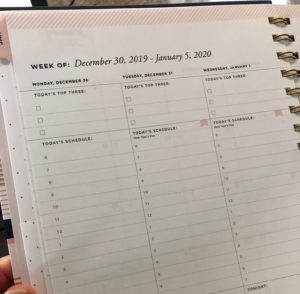“Every day may not be good. But there’s something good in every day.”
Raise your hand if you’ve ever made a New Year’s Resolution. Keep it up if you stuck with that resolution…forever.
January is all about resolutions but, unfortunately, most New Year’s Resolutions fail within the first few weeks. There are all kinds of reasons resolutions tend to fail but that’s not why I’m here.
Rather than talk about New Year’s Resolutions, let’s focus on something that has a great chance of success: creating healthy habits.

A new year means a new journal to track healthy habits.
This year on the blog, I’m introducing a monthly series of opportunities to create healthy habits. These are not monthly challenges, 30-day challenges, or weekly challenges – they’re not challenges.
Anyone can take on a challenge for a few days or weeks and complete it…but, then what? I believe that’s a problem with typical challenges. Sure, the work put in is great but then the challenge is done, and things go back to normal.
What I’m here to do is offer opportunities. Unlike challenges people try to conquer, opportunities are meant to be seized. They’re chances to do something you really want to do. If that includes building healthy habits, that last long after the first days, weeks, or months, then you’ll want to join in.
Opportunities to Create Healthy Habits
There’s no secret formula for how to create healthy habits. Like anything that’s important to us in life, they’ll be prioritized and continued. However, a few basics are needed to get started.
First, there has to be a want, a real desire. If you don’t really want to do something, it’s going to lose its luster, be deprioritized, and fade away. Choose to build healthy habits around things you really want.
Second, there has to be a goal. More on that later.
I’m excited to share my first installment of this series, aimed, not at offering up another tired 30-day challenge or month challenge, rather a helpful set of tips that can be used to create a healthy habit – one that sticks.

Grateful for running.
And I’m especially excited to start with one that’s super easy and so impactful – yet I’m not sure many people actually do this: practice gratitude.
Practicing Gratitude
One of the habits I worked hard to create in 2019 was creating a habit of gratitude. It started as a weekly journal entry, then progressed from there and, today, is part of my daily morning mindfulness routine, as well as a daily journal entry.
And I swear it has made me happier, and more focused and calm, in addition to helping me better prioritize my life and time.
If you could benefit from building a gratitude habit, please read on for three tips that will help build the habit.
How to Create Healthy Habits
But first, back to the foundation. Like any habit, the desire and a goal along with it are important. Please don’t go into this with anything less than both.
First ask yourself, why do I want to build this healthy habit? Do I really want to or do I feel like I should? Find that purpose, that desire.
If you really want to, the second step is to set your goal. It’s not enough to say, “I want to build a habit of gratitude.” What does that mean? Does it mean daily or would starting with a weekly practice be enough to get going? A goal gives you something to measure, something to gauge success, and see where adjustments or improvements could be made.
Okay, now that the two basic foundations of healthy habits are there, let’s get on with the gratitude.
Tip #1 – Pick the Right Time
Morning, noon, Monday or Friday,– there are 24 hours in the day and 7 days in the week, and, with that, countless opportunities to practice gratitude. However, I believe an important part of making any habit stick is fitting it in when it works best for you.
For example, when I started my weekly, morning gratitude habit, it went well. Then I decided I wanted to expand it to a daily, morning gratitude habit. Success! Then, I attempted to expand it by adding another session of journaling, this time at the end of the day. That one didn’t stick.
Why? I have a morning routine and mornings are my best time for writing. Conversely, I don’t have a nighttime routine and nighttime isn’t my best time for writing. I’ve stuck with my gratitude habit by focusing time when I know it works best for me – in the morning.
Tip #2 – Figure Out the Way
You can speak it. You can write it. You can tweet it. However you choose to express your gratitude, do it in the way that is most appealing to you – if it’s natural, it’s more likely to stick as a habit vs. forcing something that’s not intuitive.

With great friends like this, it’s easy to find gratitude.
For example, when I started my gratitude habit, I set out to tweet it – a daily gratitude tweet. I figured it would it be good for me and maybe someone else would see it and get a good feeling. That one didn’t stick.
Why? I’m not a phone person. I’m not really even a social media person, unless I’m doing something intentionally on a platform. I chose to focus on what I am – a writer. I love to write so keeping a gratitude journal is something I do every day, with enjoyment.
Tip #3 – Decide What the Habit Looks Like
Now that the timing and the method is nailed down, what does an actual gratitude practice look like? It can be anything! But for those who need a starting point, here are a few ideas for how to express gratitude – first, the easily repeatable methods, what I call ‘Static Gratitude’ that are especially good options for those looking to develop a consistent daily or weekly habit.
Static Gratitude
1. Choose something you’re grateful for that can be summed up in a single word or phrase, whether written, silent thought, spoken, even illustrated:
-Coffee or Starbucks coffee
2. Create a daily mantra that changes; whether a written statement, silent thought, or spoken phrase:
-Today, I am grateful for ______/ to be_______ / because ______
3. Share it with a friend or family member; via a phone call, in-person, social message, etc.:
-A text could be: Thank you, Jenny, for inviting me to bootcamp class last week. I’m grateful for our friendship and shared love of fitness!
Finally, there’s the option of what I call, ‘Spontaneous Gratitude.’ While this is one that can’t necessarily be planned, it can be done consistently daily or weekly. Spontaneous gratitude is still a wonderful practice, it’s about being mindful, building awareness of situations to recognize it, then committing to fulfill it.
4. Share it with a stranger; make a point to show gratitude to someone you don’t even know:
-My colleague, Jim, does a wonderful job of recognizing and thanking people when we’re at restaurants, the airport, wherever – his simple, “Thank you for the work you’re doing, I appreciate it,” comment always leaves that person smiling.
5. Instead of complaining, find a positive:
-When I have a tough day at work, I recognize it (because it’s okay to be upset! Gratitude doesn’t mean you’re not still allowed to be sad, pissed, or frustrated) but rather than complain, I remember that I get to write and tell stories for a living. I get to do what I love, every day. If I wanted an easy, stress-free job, I’m sure I could find one. But I chose this one and am grateful it’s what I get to do – boom, gratitude realized.
If you’re following along and ready to create a gratitude habit, please let me know if this post helped – or, please share it on social media if you believe it will help others build a healthy habit of gratitude.
And of course, the comments are your space to share thoughts so please do so.
Connect with me @lindsayinreallife on Instagram or @LindsayIRL on Twitter. Subscribe to Wellness in Real Life so you get every new blog post straight to your inbox.
